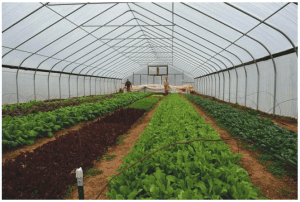Area produce farm keeps on trucking through the cold

While the rest of us are wondering how we can keep from freezing during this week’s cold spell, at Green Edge Gardens in Amesville they’re harvesting fresh greens and other tasty edibles, as they do all winter.
For a decade Kip and Becky Rondy have run the farm, nestled in a picturesque valley, and for most of that time they’ve employed an innovative distribution model in which many of their vegetables are sold via subscription to area residents.
Growing food during the cold months is made possible by 10 long greenhouses made of plastic over tubular frameworks. The plants are covered until the warmest parts of the day, when the tarps are pulled back and they receive sunlight – which also warms the ground between and around them.
“While we sell wholesale to restaurants, we’re also a CSA,” explained Claudia Barshaw, who handles that part of the farm’s business. What is a CSA? “It’s community supported agriculture,” which in this case means that people may buy subscriptions, called “shares,” and once each week they receive a delivery of freshly grown vegetables and other locally produced foods.
“People can also get half-shares – they receive the same sized bag of food, but it’s once every two weeks,” Myers said.
It’s a model reminiscent of the day when neighborhood farms sold food in their immediate areas, when it was more local than the prevailing food distribution system is now. At Green Edge Gardens the arrangement is called the Athens Hills CSA.
The farm’s service area concentrates on Athens, Belpre, Marietta and Columbus, she said. And being local and relatively small, the farm is more attentive to customer wishes and comments.
“The goal is to provide year-round jobs,” explained Kip Rondy. “A lot of agricultural work is seasonal, but what we’re trying to do is provide good-paying jobs for the whole year.”
The steady work has largely panned out – there are currently 10 farm employees, while in the summer, for a crop that includes outdoor vegetables, 14 work there, he said. Providing pay sufficient for employees to thrive is a more elusive goal. “We’ll achieve it when we become more efficient and get some more equipment,” he said. Many of the employees started at the farm as interns. And many have been involved in other public works and alternative-systems projects.
What looks at first to be an ordinary, even sleepy, farm building houses one of the more unusual aspects of the already unusual Green Edge Gardens: the mushroom farm. In a warm, moist, dimly lit room that smells earthy and delicious, two employees raise Shiitake and oyster mushrooms, which grow on specialized plugs of compressed sawdust and other organic materials. The plugs, resembling enormous wood-stove pellets for the Shiitakes and tall plastic-wrapped bags with holes punched in them for the oysters, arrive at the farm pre-inoculated with spores of the respective mushrooms. Each is good for as many as three harvests; then they’re composted.
Around the corner in the same building is the packing room, the domain of Emily Hammon, who has been managing it for more than two years, “and before that I was an intern.” Here, the fresh produce is washed, spun, weighed, bagged and labeled.
A nearby building is the microgreens greenhouse. Microgreens are plants harvested after being sprouts and before becoming fully-formed plants, more or less seedlings. They’re crunchy, tasty and nutritious. The farm offers them as mixed microgreens, though the popular sunflower microgreens are available separately.
“They’re good in salads or on sandwiches and as a garnish,” said Paula Gerdman as she snipped some with a pair of kitchen scissors. They went into a large stainless bowl; in the packaging room, they’ll be weighed out in three-ounce bags. Incidentally, three ounces of microgreens are more than you think. Especially tasty are the sunflower microgreens.
Descending into the valley, one finds the rows of larger greenhouses, oriented so as to maximize sun exposure and minimize vulnerability to the wind. The variety of produce grown there is diverse; at any given time during the winter one might find greens including arugula, collards, beets, kale, pac choi, and spinach, and sometimes others, as well as root vegetables such as beets, carrots, green onions, and particularly sweet and tasty Japanese turnips. Interspersed among the varieties being harvested are “companion plants.” It’s been discovered that certain plants grow especially well in the presence of other plants.
Inside the greenhouses, the plants are covered overnight, the gigantic tarps then rolled back by hand during the parts of the day that are closest to warm, during which the harvest takes place. Surprisingly, the cool weather can make for more flavorful produce. “Try this,” said Rondy, offering a stem of kale. “Taste the sweetness? The plant produces sugar as a defense against freezing. If it got warm, that sweetness would disappear in just a few hours.”
Crossing a small stream that provides drainage to the valley’s bottom, he points to the fields where during the normal growing season common garden vegetables are grown, though now they’re seeded with winter wheat and winter rye, which add nutrients to the soil. Everything grown by Green Edge Gardens is certified organic.
The farm offers a variety of subscriptions – called “shares” – which can at shareholder request include products from other local agricultural businesses including honey from Cantrell Honey, fruits from Cherry Orchards, free-range eggs from High Bottom Farm, cheeses from Integration Acres, popcorn and beans from Shagbark Seen and Mill, milk from Snowville Creamery, Sticky Pete’s Pure Maple Syrup, and a variety of breads from Village Bakery and Cafe.
“In return, they promote us on their web pages and in other ways,” said Becky Rondy.
“This is the future of food production,” noted Kip Rondy. “It combines things. It’s local, it’s sustainable, it provides jobs.
“And it’s good food.”
From The Athens News | January 7, 2015 | by Dennis Powell



